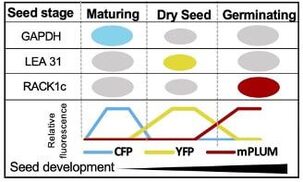Theme 2: Rehydration & recovery From desiccation
Shades of protection and survival
|
What are the genetic & metabolic milestones of recovery from desiccation?
 Stage-specific expression of seed markers.
Stage-specific expression of seed markers.
We aim to quantify desiccation recovery using transcriptome and proteome responses to rehydration paired with direct observations. We will perform proof-of-concept experiments with Arabidopsis embryos. We expect that transcriptomic and proteomic data will identify gene expression and protein level changes between embryo desiccation stages, and will be invaluable for further investigation into factors and processes driving desiccation and rehydration processes.
How does partial re-hydration affect desiccation tolerance?
Desiccation tolerant organisms are frequently exposed to relative humidity between 50 and 90%, which does not allow cellular vitrification nor recovery metabolism. The nature of metabolism at partial hydration, when cells and organisms come out of their suspended life, is not well understood, but it is known to eventually cause death in many desiccation-tolerant organisms while allowing xerophilic organisms to persist and grow. What modulates this difference is currently not known though cellular viscosity is implicated to play a critical role. We propose that variation in glass fragility (change in cellular viscosity with RH) between pairs of desiccation sensitive and tolerant organisms explains successful entry into a solid state. Here, we suggest that strong glasses may also protect organisms as they exit the solid state, by limiting catabolism until viscosity declines sufficiently to allow growth and repair. We hypothesize that organisms at relative humidities between 50 and 90% correlate with lost desiccation tolerance and are modulated by the cytoplasm viscosity.













